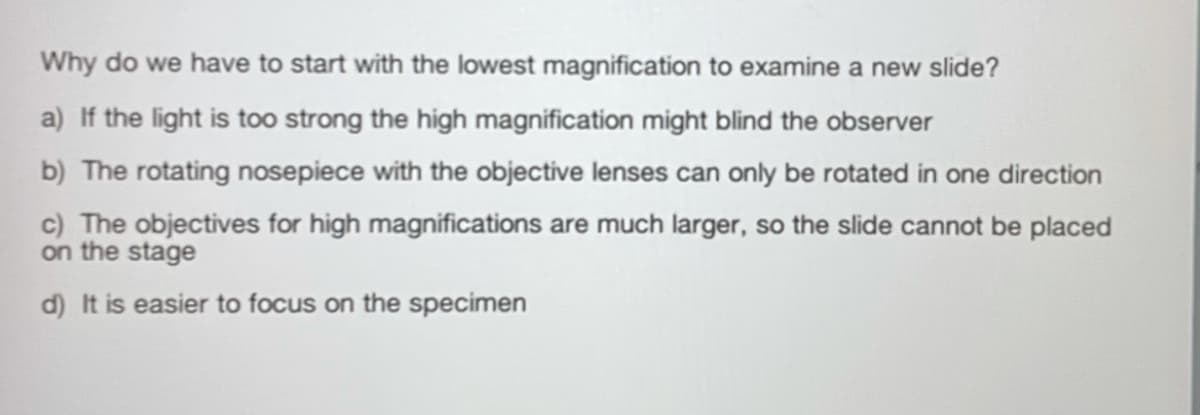Why do we have to start with the lowest magnification to examine a new slide? a) If the light is too strong the high magnification might blind the observer b) The rotating nosepiece with the objective lenses can only be rotated in one direction c) The objectives for high magnifications are much larger, so the slide cannot be placed on the stage d) It is easier to focus on the specimen
Why do we have to start with the lowest magnification to examine a new slide? a) If the light is too strong the high magnification might blind the observer b) The rotating nosepiece with the objective lenses can only be rotated in one direction c) The objectives for high magnifications are much larger, so the slide cannot be placed on the stage d) It is easier to focus on the specimen
Principles Of Radiographic Imaging: An Art And A Science
6th Edition
ISBN:9781337711067
Author:Richard R. Carlton, Arlene M. Adler, Vesna Balac
Publisher:Richard R. Carlton, Arlene M. Adler, Vesna Balac
Chapter13: X-ray Interactions
Section: Chapter Questions
Problem 7RQ
Related questions
Question
Which answer is true? ?

Transcribed Image Text:Why do we have to start with the lowest magnification to examine a new slide?
a) If the light is too strong the high magnification might blind the observer
b) The rotating nosepiece with the objective lenses can only be rotated in one direction
c) The objectives for high magnifications are much larger, so the slide cannot be placed
on the stage
d) It is easier to focus on the specimen
Expert Solution
This question has been solved!
Explore an expertly crafted, step-by-step solution for a thorough understanding of key concepts.
This is a popular solution!
Trending now
This is a popular solution!
Step by step
Solved in 4 steps

Knowledge Booster
Learn more about
Need a deep-dive on the concept behind this application? Look no further. Learn more about this topic, biology and related others by exploring similar questions and additional content below.Recommended textbooks for you

Principles Of Radiographic Imaging: An Art And A …
Health & Nutrition
ISBN:
9781337711067
Author:
Richard R. Carlton, Arlene M. Adler, Vesna Balac
Publisher:
Cengage Learning

Principles Of Radiographic Imaging: An Art And A …
Health & Nutrition
ISBN:
9781337711067
Author:
Richard R. Carlton, Arlene M. Adler, Vesna Balac
Publisher:
Cengage Learning